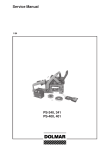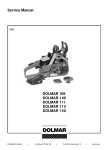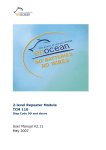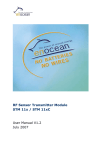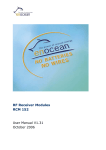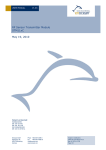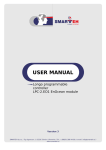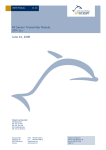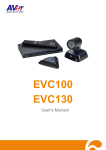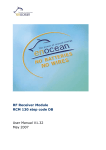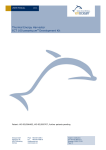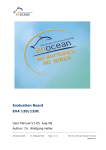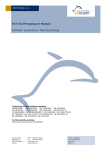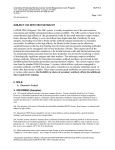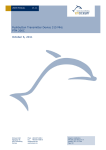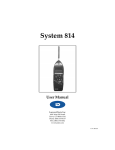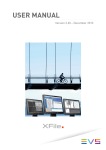Download EVA 100 User Manual
Transcript
Evaluation Kits EVA 100 and EVA 105 User Manual V1.7 April 2007 Revision History The following major modifications and improvements have been made to the first version of the document (EVA 100 User Manual V1.0): No Subject (major change since last version) V1.1 No major changes V1.2 Chapter “Operating Modes” added, chapter “Getting Started” revised V1.3 Chapter “Description of On-board indicators” revised V1.4 New version for TCM 120 support V1.5 EVA 105 included (US version with 110V power supply) V1.6 Batteryless pushbutton transmitter PTM 100 is replaced by type PTM 200 V1.7 STM100 replaced by STM110, EVA Mon replaced by WinEtel software Published by EnOcean GmbH, Kolpingring 18a, 82041 Oberhaching © EnOcean GmbH All Rights Reserved Attention please! The EVA evaluation kit is for laboratory use only! This information describes the type of component and shall not be considered as assured characteristics. No responsibility is assumed for possible omissions or inaccuracies. Circuitry and specifications are subject to change without notice. For the latest specifications, refer to the EnOcean website: http://www.enocean.com. As far as patents or other rights of third parties are concerned, liability is only assumed for components, not for applications, processes and circuits implemented within components or assemblies. EnOcean does not assume responsibility for use of devices described and limits its liability to the replacement of devices determined to be defective due to workmanship. Devices or systems containing RF components must itself meet the essential requirements of the local legal authorities. EnOcean GmbH does not recommend the use of its products in life support applications and will not knowingly sell its products for use in such applications unless it receives an adequate "products liability indemnification insurance agreement". Components of the modules are considered and should be disposed of as hazardous waste. Local, government regulations are to be observed. ©EnOcean GmbH Page 2 of 12 User Manual EVA 100, V1.7 Table of Contents 1. EVA General Kit Description .......................................................................................4 2. Scope of EVA 100 Kit Supply and Ordering Information..................................................5 2. Scope of EVA 105 Kit Supply and Ordering Information..................................................6 4. On-board Overview EVA 110 (Board) ..........................................................................6 5. Board Dimensions and Environmental Conditions ..........................................................7 6. Description of On-board Connectors ............................................................................7 7. Description of On-board Indicators..............................................................................8 8. Description of On-board Switches ...............................................................................8 9. Description of RCM Operation Modes ...........................................................................9 10. Getting Started .................................................................................................... 10 11. Changing the Operation Mode ................................................................................ 10 12. Serial Interface (RCM 120 Operating Mode 0 / TCM 120 mode) ................................... 11 13. Application Monitor EVA-MON ................................................................................. 11 14. TCM Monitor ........................................................Fehler! Textmarke nicht definiert. 15. EVA 110 Circuit Diagram ....................................................................................... 11 ©EnOcean GmbH Page 3 of 12 User Manual EVA 100, V1.7 1. EVA General Kit Description EVA 100 and EVA 105 are evaluation kits to support the development of applications based on the EnOcean RCM receiver modules and the TCM transceiver modules. The kits support a quickly evaluation of all RCM receiver operation modes as well as a quite easy setting-up operation of the receiver side when EnOcean transmitter modules are evaluated. Figure: EVA EnOcean Evaluation Kit PTM Push-Button Powered Transmitter • The PTM radio transmitter modules from EnOcean enable the implementation of wireless remote controls without batteries. Power supply is provided by a built-in pressure energy converter. • Key applications are on-wall mountable flat rocker switches or handheld remote controls. STM 110 Solar Powered Transmitter • The extremely power saving RF transmitter module STM 110 of EnOcean enables the realization of wireless and maintenance free sensors. • Power supply is provided by a small solar cell. An integrated energy store allows unrestricted functionality for several days in total darkness. • Three 8 bit A/D converter inputs and 4 digital inputs facilitate multifunctional detector systems, based on application specific passive sensing components. This allows easily and comfortable monitoring of position, temperature, illumination, pressure, etc. - or simply supervising voltages or currents. ©EnOcean GmbH Page 4 of 12 User Manual EVA 100, V1.7 RCM 110 Receiver Functionalities • Logic output signals controlled by EnOcean PTM Switches: Switching (on/off, 1 to 4 channels) or Dimming (PWM 50 kHz with switch-off value memory) • Scene selection control (6 light scenes, all-on/off) • Learning procedure for EnOcean PTM transmitters, easy to operate RCM 120 Receiver Functionalities • 9600 bps serial data link from all EnOcean RF transmitters (e.g. PTM, STM). This interface facilitates any desired actor functionality by the user • Logic output signals controlled by EnOcean PTM Switches: Tubular Motor Control (up/down with slat acting, 1 or 2 motors) or Pushbutton (pressed/released) • Learning procedure for EnOcean transmitters, easy to operate (optional within serial data link) TCM 120 Receiver Functionalities (TCM 120 not contained in EVA 100 / EVA 105): • 9600 bps bi-directional serial data link from all EnOcean RF transmitters (e.g. PTM, STM) and to all EnOcean radio receivers. The detailed functionality of all EnOcean radio modules are described in the actual documentation corresponding to the versions of the used modules. 2. Scope of EVA 100 Kit Supply and Ordering Information Type EVA 100 Content / Description Ordering Code 1) Short User Instruction “Get Started” S3004-G100 2) EVA 110: EnOcean Evaluation Board (PCB) 3) 230V/50Hz wall power supply 4) CD with WinEtel SW application, and user documentation 5) PTM 200: EnOcean Pushbutton Transmitter with Test Rocker 6) STM 110: EnOcean Sensor Data Transmitter Module with Solar Cell 7) RCM 110: EnOcean Receiver Module 8) RCM 120: EnOcean Receiver Module 9) Equipment case ©EnOcean GmbH Page 5 of 12 User Manual EVA 100, V1.7 2. Scope of EVA 105 Kit Supply and Ordering Information Type EVA 105 Content / Description Ordering Code 1) Short User Instruction “Get Started” S3004-G105 2) EVA 110: EnOcean Evaluation Board (PCB) 3) 120V/60Hz wall power supply 4) CD with WinEtel SW application, and user documentation 5) PTM 200: EnOcean Pushbutton Transmitter with Test Rocker 6) STM 110: EnOcean Sensor Data Transmitter Module with Solar Cell 7) RCM 110: EnOcean Receiver Module 8) RCM 120: EnOcean Receiver Module 9) Equipment Case 4. On-board Overview EVA 110 (Board) Figure: On-board connectors, switches and indicators ©EnOcean GmbH Page 6 of 12 User Manual EVA 100, V1.7 5. Board Dimensions and Environmental Conditions - The dimensions of the EVA board are 180 x 80 x 23 mm - The EVA evaluation board has been designed for laboratory use only (room temperature, indoor) 6. Description of On-board Connectors Symbol Function Adaptor Female jack for power supply RCM/TCM Female header for plug-in RCM or TCM module (Pin 1 is module antenna side) Test Connector Female header connected directly to module leads Vcc Jack to disconnect the power supply to the inserted module GND GND Ground connectors for functional control outputs Operational characteristics 14 - 30 V, 100 mA max. Bridge R0 R1 R2 R3 Functional control outputs directly connected to the OUT_0..3 output pins of inserted module Open collector outputs: 35 V max., 100 mA max., 100 mW max. each GND EVG Analog output to drive an Electronic Control Gear (RCM 110, Mode 5 only) 0 to 10 V, 20 mA max. GND PWM 50 kHz PWM output (RCM 110, Mode 5 only) 5 V TTL, 20 mA max. RS232 DB9 female serial interface connector to PC • RCM 120, Operating Mode 0 (Rx) • TCM 120 (Rx an Tx) 12 V TCM RCM Selector for RCM or TCM module operation Bridge ©EnOcean GmbH Page 7 of 12 User Manual EVA 100, V1.7 7. Description of On-board Indicators Symbol Function Power Power supply indicator Signal indicator Indication output of received signal strength of all 868.3 MHz signals (peak detection) • Red: No Radio Signal • Yellow: Weak Radio Signal • Green 0..2: Strong Radio Signal I0 I1 I2 I3 Status indicator of functional control outputs. Also indicate current learning mode status (see RCM 110/120 User Manual “Learning of radio transmitters”) LMI Learning Mode indication output: LMI is shining in the learning mode phase 8. Description of On-board Switches Symbol Function MODE Encoding switch for operation mode selection of RCM 110/120 (ON is active GND connection): switch 1 = CODE_0 switch 2 = CODE_1 switch 3 = CODE_2 The operation mode is defined with the pin status at power-up. A change of the operation mode is possible with cleared ID memory only (see CLR). LRN(Grey) Pushbutton to enter transmitter learning mode: Teaching of switch rockers and sensor modules into the receiver by triggering the transmitter telegram at least one time SSLM(Black) Pushbutton to enter scene switch learning mode CLR(Red) Pushbutton to clear the receiver ID and scene memory (all learned switch rockers, sensors and scene switches) ©EnOcean GmbH Page 8 of 12 User Manual EVA 100, V1.7 9. Description of RCM Operation Modes Mode switch 1 2 RCM Function 3 0 0 0 RCM 120 Serial data link (9600 bps, 1 start bit, 1 stop bit). 1 0 0 RCM 120 Pushbutton 0 1 0 RCM 110 Switching 1 channel 0 1 0 RCM 120 Turbular motor control 2-channel 1 1 0 RCM 110 Switching 2 channel 0 0 1 RCM 110 Switching 4 channel 1 0 1 RCM 110 Dimming PWM 50 kHz, switch off value memory 0 1 1 RCM 120 Tubular motor control 1 1 1 RCM 110 Test / not documented RCM 120 Output Indicator I0 – I4 on-board connectors I0, R0: Serial data open collector RS232: Serial data (Use PC Software EVAMON contained on CDROM) One-to-one copy of pushbutton actions “O-button pressed/released” at I0, R0 and “I-button pressed/released” at I1, R1 Logic switching state “on/off” at I0, R0 when pushing the switch rockers Channel 1: “Open/Up” at I0, R0 “Close/Dn” at I1, R1 Channel 2: “Open/Up” at I2, R2 “Close/Dn” at I3, R3 Logic switching state “on/off” at I0, R0 (Ch1) and I1, R1 (Ch2) when pushing the switch rockers Logic switching state “on/off” at I0-4, R0-4 (Ch1-4) when pushing the switch rockers I0, R0, PWM: Inverted Output PWM EVG: Output 1-10V to connect external Dimming EGC “Open/Up” at I0, R0 “Close/Dn” at I1, R1 The detailed functionality of the EnOcean transmitter and receiver modules is described in the documentation corresponding to the versions of the used modules. ©EnOcean GmbH Page 9 of 12 User Manual EVA 100, V1.7 10. Getting Started 1. Carefully read the User Manuals on the EVA-CD 2. Unpack the EVA-PCB from the suitcase and put it on a non conductive flat base 3. Plug the RCM 110 or RCM 120 receiver module into the RCM 100 connector. Remark: RCM connector pin 1 is at antenna cable side 4. Select the desired receiver operation mode by the MODE dip switch. Please refer to table “Description of Operation Modes” and the actual documentation of RCM 110/120. (Example: For “Switching 1 channel” use RCM 110 with switch 1 off, switch 2 on, switch 3 off) 5. Connect the power supply 6. Press the CLR pushbutton until LMI is on (Remark: The operation mode is defined with pin status at power up, a change of operation mode is possible with cleared ID memory only. So this initial CLR procedure avoids initialization errors in cause of not cleared ID memories) 7. After I0 starts blinking, EnOcean transmitters can be learned by sending a telegram. (Example “switching 1 channel”: Operate the PTM transmitter with mounted demorocker one time). For learning confirmation I0 is on for 4 seconds 8. Press pushbutton LRN to change to the next channel (in multi channel modes only, then I1 is blinking next) or to leave learn mode (LMI is off) 9. When LMI is off, the application is ready for operation. (Example “Switching 1 channel”: Operating the PTM switches on/off I0-LED and the corresponding R0 output) 10. For changing the operation mode again, please disconnect the power supply and continue with step 4 11. Changing the Operation Mode 1. Press the CLR pushbutton until LMI is on (Remark: The operation mode is defined with pin status at power up, a change of operation mode is possible with cleared ID memory only. So this CLR procedure avoids initialization errors in cause of not cleared ID memories) 2. Disconnect the power supply 3. Select the new desired receiver operation mode by the MODE dip switch 4. Connect the power supply 5. Press the LRN pushbutton until LMI is on. After I0 starts blinking, EnOcean transmitters can be learned by sending a telegram. ©EnOcean GmbH Page 10 of 12 User Manual EVA 100, V1.7 12. Serial Interface (RCM 120 Operating Mode 0 / TCM 120 mode) When the TCM 120 transceiver is used or the RCM 120 receiver is in mode “Serial Interface”, it transfers out data blocks of information from the received radio telegrams. All received EnOcean-telegrams will be transferred. The data block format is explained in detail in the user manuals of TCM 120 and RCM 110/120. By connecting the on-board RS232 DB9 connector through a not crossed connector cable to a serial PC port, the received data can be directly operated by the PC through the application WinEtel which is scope of EVA 100 supply. When the TCM RCM bridge is set to TCM mode, the serial connection is bi-directional. Then it is also possible to transmit telegrams. For a detailed description of the WinEtel application please refer to the HELP menu in WinEtel. 13. Application WinEtel Please start the setup program from CD-Rom and follow instructions. Please refer to the HELP menu in WinEtel for a detailed description of functionalities. 15. EVA 110 Circuit Diagram See next page ©EnOcean GmbH Page 11 of 12 User Manual EVA 100, V1.7 ©EnOcean GmbH Page 12 of 12 User Manual EVA 100, V1.7












